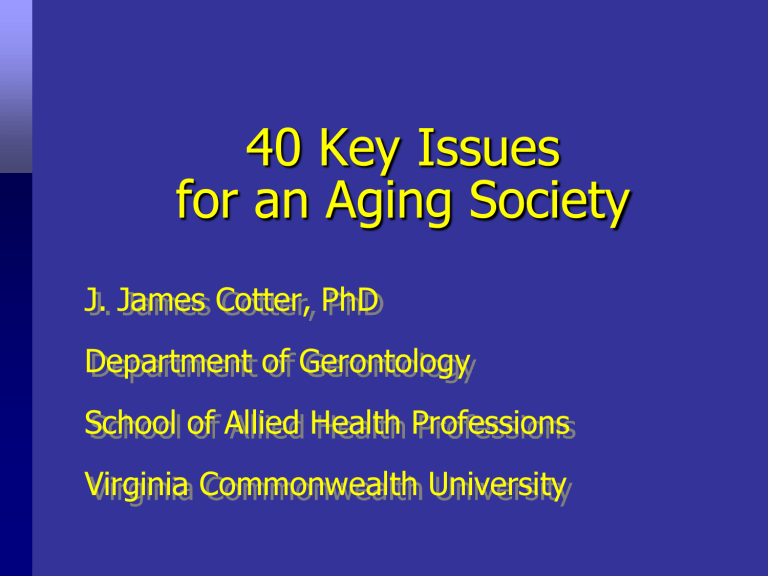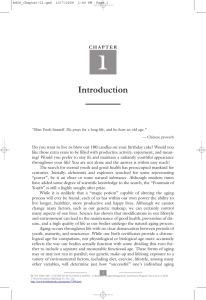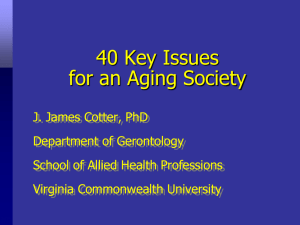Slides - Virginia Commonwealth University

40 Key Issues for an Aging Society
J. James Cotter, PhD
Department of Gerontology
School of Allied Health Professions
Virginia Commonwealth University
Boomer or Not: Aging Tide
16%
Changing structure of society
• Traditional aging pyramid • New aging pyramid
100
80
60
40
20
0
100
80
60
40
20
0
Population Pyramids:
1950/2020
(US Census Bureau)
How old is old?
• 40 - Age discrimination
• 50 - AARP discounts
• 65-67 - Medicare and Social Security
• 75 - frailty marker
• 85 - the old-old
• 100 – The new centenarians
Centenarians
Jeanne Calment, oldest person ever, died in
1997 at the age of 122.
70000
60000
50000
40000
30000
20000
10000
0
1900 2000
How old is Grandpa?
Grandpa says: “I was born before” :
• television
• penicillin
• polio shots
• frozen foods
• Xerox
• contact lenses
• Frisbees
• the pill
• credit cards
• laser beams
• ball-point pens
• pantyhose
• air conditioners
• dishwashers
• clothes dryers
• Pizza Hut
• McDonald's
• instant coffee
Life Expectancy
National Vital Statistics Report, Vol. 47, No. 28, December 13, 1999
National Research Council, 1988
90
80
70
60
50
40
30
20
10
0
1900 1920 1940 1960 1980 1997
At birth
At 65
Diverse Elders
50
40
30
20
10
0
100
90
80
70
60
1990 2030
Other
Hispanic
Black
White
A New Diversity
• Age
• Ethnicity/Race
• Gender
• Physical abilities
• Sexual orientation
• Family structure/
Marital status
• Religious beliefs
• Education
• Income/Wealth
• Work/
Employment
Generations United? Yes!
• A 1996 Cato Institute survey found that
68 percent of the public had a favorable opinion of Social Security.
• About 90 percent of people below retirement age agreed that "Maybe I won't need Social Security when I retire, but I definitely want to know it's there just in case I do." (AARP, 1996)
Increase in Sq. Footage of US
Homes
What’s your house’s IQ?
• “ ‘Smart’ house devices may help elderly stay home.”
Richmond Times-Dispatch, 5/4/03
• ‘Gait monitors’ measure changes in person’s walking and detect falls
• Florida VA uses video phones to monitor health of 1200 older persons
• Computer companion reminders
Elders and the Internet
60%
40%
20%
0%
Current elders
Aged 50-64
Source: Elderly surfing the web, 2004, San Jose Business Jrnl
Global Aging – Growth Young vs Old
2000-2035, in Billions
1.0
0.8
0.6
0.4
0.2
0.0
Under age 21
Age 65+
Healthier Older Population
• Fries (1984), Compression of morbidity
• Palmore (1986), relative health of elderly has improved
• Rogers (1990), living longer and healthier
• Manton (1995), significant decreases in prevalence of 16 medical conditions
• Cassel (2000), declining or postponing disease
% aged reporting limitation in activities of daily living
100
80
60
40
20
0
65-69 70-74 75-84 85+
Adapted from Admin. on Aging, 1997
Need for Primary Care
Physicians:Geriatrics
40000
35000
30000
25000
20000
15000
10000
5000
0
1997 2000 Needed Now Needed 2030
Source: Alliance for Aging Research, 2002
Ronald Klatz, M.D.
founding physician of the anti-aging medicine movement
• Today's boomers will live, on average, to see age 100. Some boomers will celebrate their 130th birthdays healthy, happy, with full mental and physical faculties intact.
• New method to collect organs from non-beating heart donors, expanding the bank of organs for transplants
• A genetically engineered "gene therapy" cure for male pattern baldness.
• At home 2-way telemedicine consultations between many elderly persons too frail, too weak, or just too busy to drive to their doctor appointment.
• Inhaled drug delivery systems e.g. Insulin
Welcome to the Calorie Restriction (CR) Society
Our goal is to help people of all ages live longer and healthier lives simply by: eating fewer calories and maintaining adequate nutrition.
Calorie Restriction...the only to modern science.
proven life-extension method known http://www.calorierestriction.org/
89 million American adults have limited health literacy skills.
•(Photo credit: Davies + Starr)
•Model of End of Life Care
•Disease modifying therapy
•Hospice
•Palliative Care
•Symptom Control/
•Supportive Care
•Bereavement Care
•Source: Education of Physicians on End of Life Care. Robert Wood Johnson Foundation
•http://www.athealth.com/Consumer/newsletter/FPN_4_25.html#1
Tools for End-of-life Care
• Will
• Advanced Directives
– Living Will
• allows you to document your wishes concerning medical treatments at the end of life.
– Durable power of attorney
• allows you to appoint a person you trust as your health care agent (or surrogate decision maker), who is authorized to make medical decisions on your behalf.
– Organ Donation
Condom Granny's safe sex pitch to Florida's active oldies
3 glasses of wine – Per WEEK
Depression
• In a study of 3,410 older persons in an
HMO, primary care physicians miss 1/2 of depression (measured by the GDS) in older persons.
– Garrard, Rolnick, Nitz et al, J Gerontology,
April, 1998
• Suicide rate for older white men is double other groups (59/100,000).
Alzheimer’s Disease
• Most common type of dementia
• 4 million people affected
• Caregivers’ 36 hour day
• Pharmacologic tx - cholinesterase inhibitors for early stages, anti-psychotics in later stages for behavior
• Non-pharmcologic tx for behavior - SCUs
Which group provides 75% of
LTC of older persons?
1) Nursing homes
2) Assisted living
3) Home health agencies
4) Friends and family
Institute on Medicine Reviews
Quality of Health Care
• Adverse events: “incidents resulting in, or having the potential for, physical, emotional, or financial liability for the patient” (Fischer et al., 1997).
• Health care error: “the failure of a planned action to be completed as intended or use of a wrong plan to achieve an aim by any health care provider involved in the continuum of care.”
• 96,000 unnecessary deaths per year
•Medicaid
•Private,
•Out of pocket
•Hospital Care •Physician services
•Prescriptions •Nursing
Homes
•Home Health
Services
•Medicare
•Medicare
Supp.
•LTC
•Insurance
Paying for health care
• Median out-of-pocket expenditure by older persons on health care =
$1,939
• Median income of older persons = $13,904
Changing Family Support
A One Child Policy
•Avg # of children per family is 1.87
Economic Value of Long-termCare
250
200
150
$
Billions
100
50
0
196
Home Health Care
Nursing Home Care
Family and Friends
32
83
Source: Arno, Levine, Memmot (1999) Health Affairs
We have met those welfare mothers and they are old.
21%
•Adults
10%
15%
51%
•Children
72%
28%
•Medicaid Beneficiaries and Payments by
Eligibility Group, 1999
• Source: CMS, CMSO, Medicaid Statistical Information System.
How do the Aging Vote?
Voting Behavior in 2000
18-29 60+
% vote 17% 24%
Kerry
Bush
54%
45%
46%
54%
Source: MSNBC per CNN
11. The OAA: Wherever You Go,
There We Are
Congress
Nat'l Aging Orgs
Governors
State Legislatures
Local Govt
President
HHS
AoA
State Units on Aging
•Based on Torres-Gil, The New Aging, p.56
AAAs
Local Service
Providers
Consumers
Labor Force Participation Rates
(adapted from Atchley & Barusch, 2004)
20
0
-20
-40
100
80
60
40
Men 55-
64
Men 65+ Women
55-64
Women
65+
1950
2008
Difference
•Six
The Three-Legged Stool of
Retirement Financing
•Assets
•Employment
•Medical
Coverage
•Social
Security
•Public
Benefits
•Pensions
(401(k)s)
For 2 of every 5 older persons,
Social Security provides
80% of their income
Source: Is Demography Destiny? National Academy on an Aging Society, Feb, 1999
Economic Impact
• Financial - 70% of the financial assets in
America
• Travel Spend 74% more on a typical vacation than 18-49 year olds
• Health - 42% of all MD office visits
• Pharmaceuticals 74% of all prescription drugs, a $103 billion market
Source: ASA Business Forum on Aging
Current Political Issues
• Cost of Prescriptions & Medicare
• Social Security (Deficit/Privatizing)
• Longevity (Financing)
• Health care costs (More HMOs)
• Long-term care (Tax Credit)
• Housing (Assisted Living)
Future: Older People of the
21st Century
• More of them
• More types of families and kinship
• More active and involved for longer
• Healthier, wealthier…wiser?
• More diverse
Aging America: Changing our World
• “continuing search for a contemporary society that is at ease with its own aging as well as its aging members.”
– Koff and Park, 1999, p. xxi
J. James Cotter, PhD
Associate Professor, Department of Gerontology
School of Allied Health Professions, Virginia Commonwealth
University
Public Health Mission
• Understand the social and demographic trends affecting an aging society.
• Reexamine the underlying principles of the present system.
• Examine the relationships between individuals, society and government.
• Assist agencies, organizations and older persons to adapt to multiple challenges



